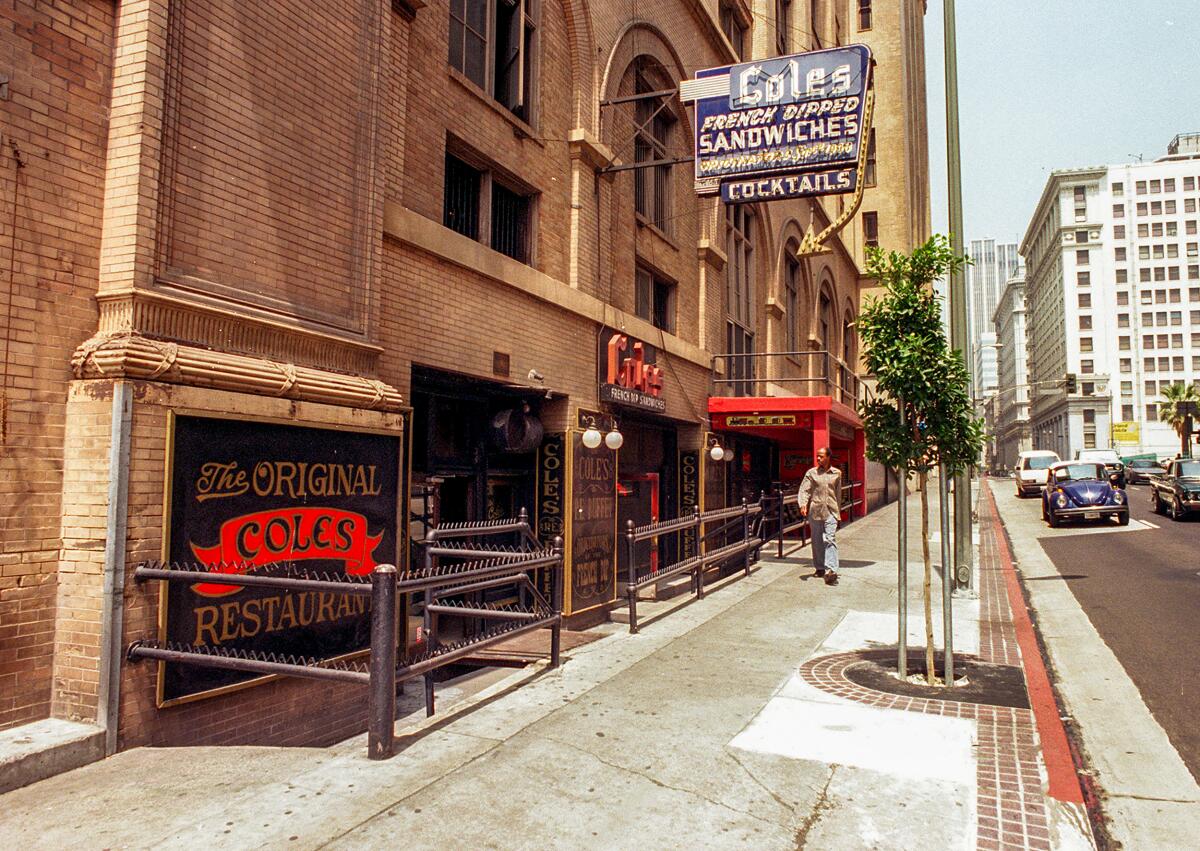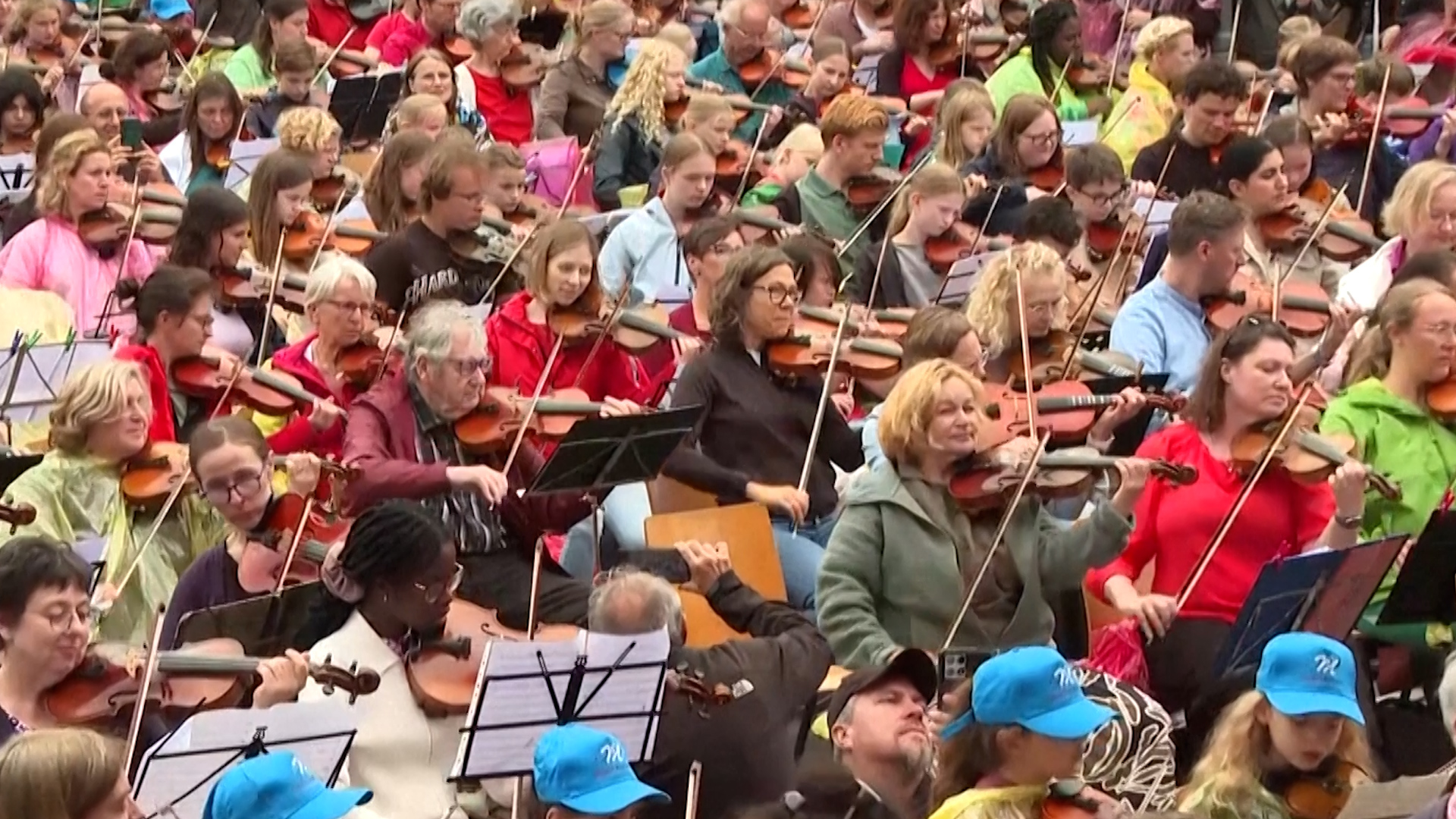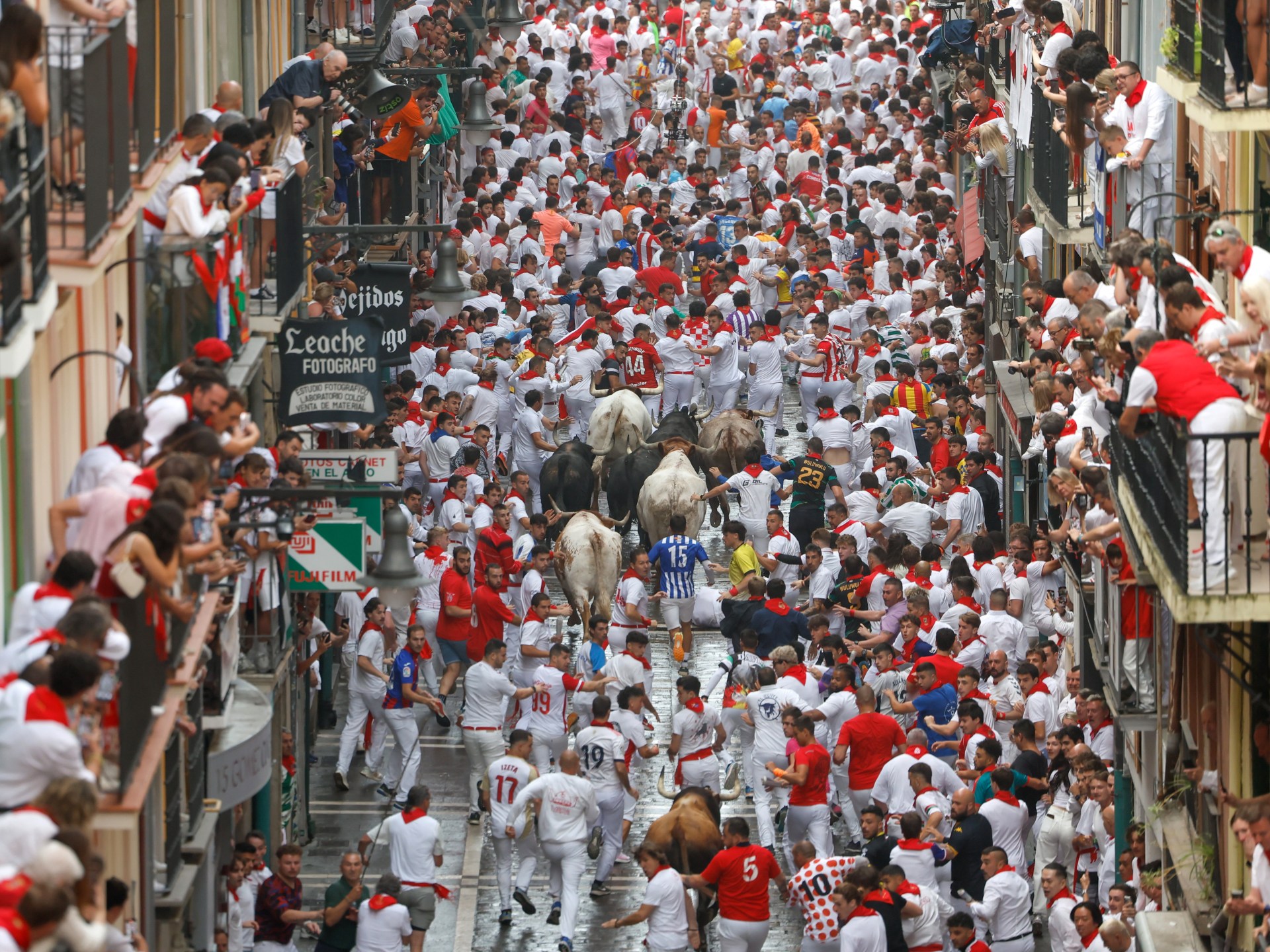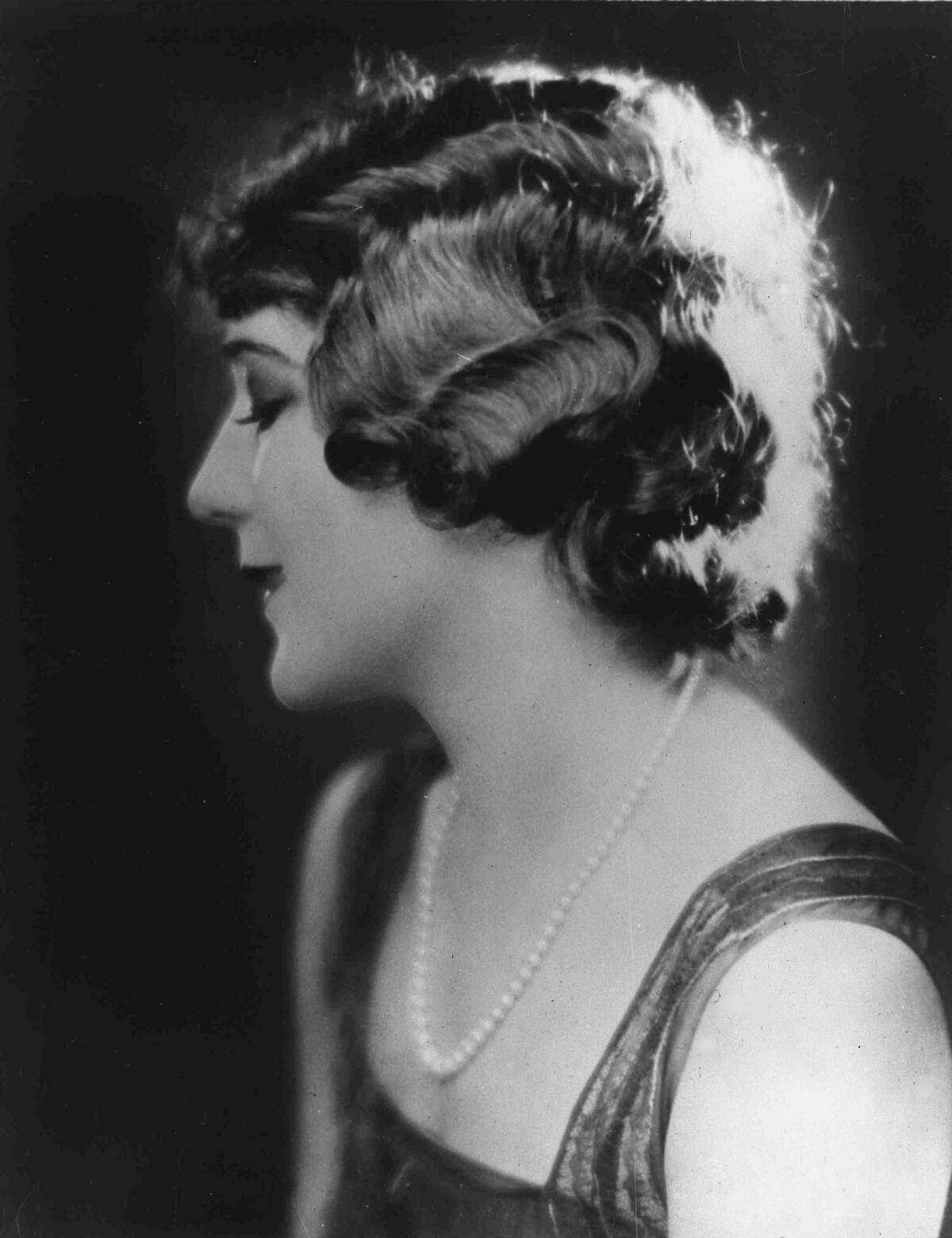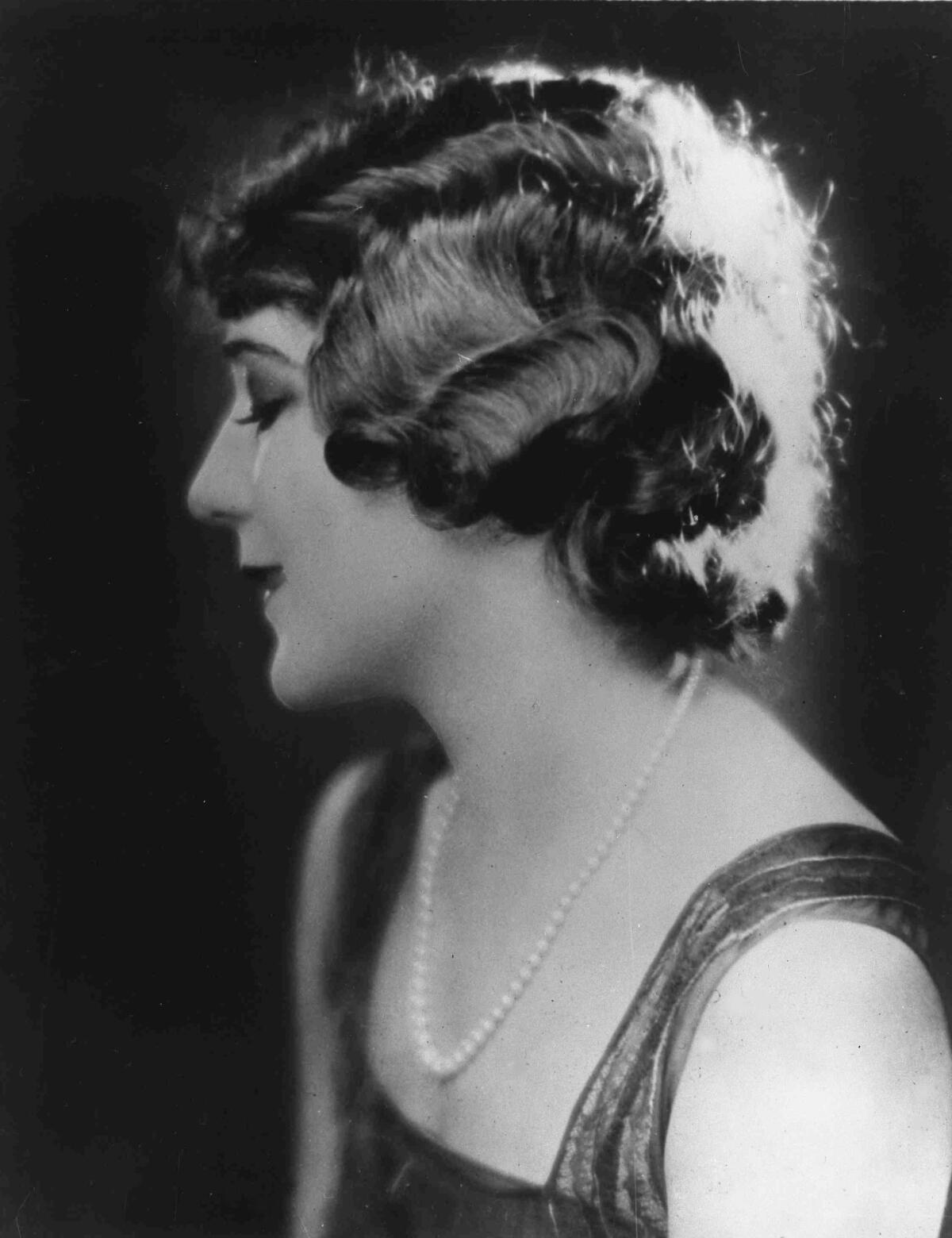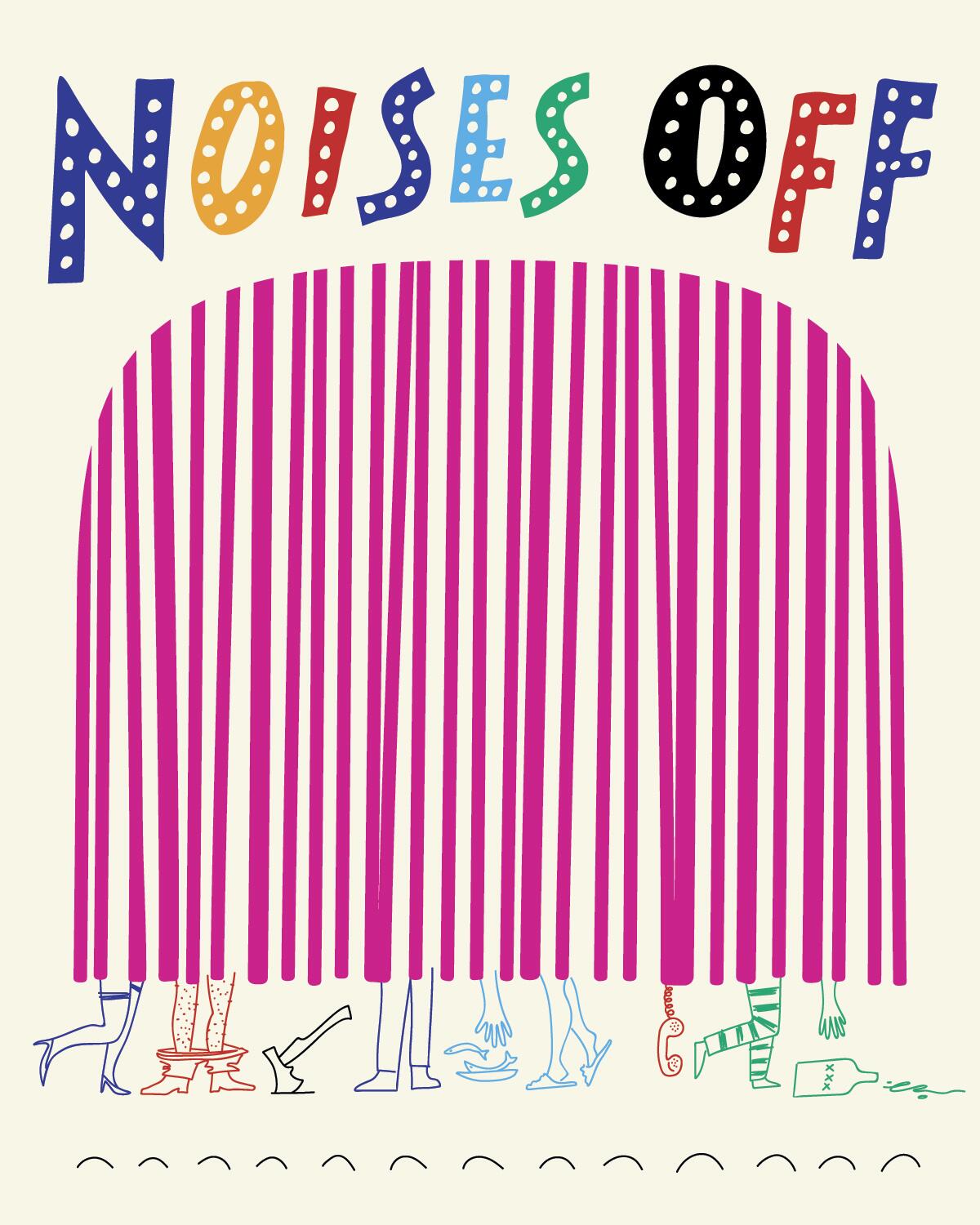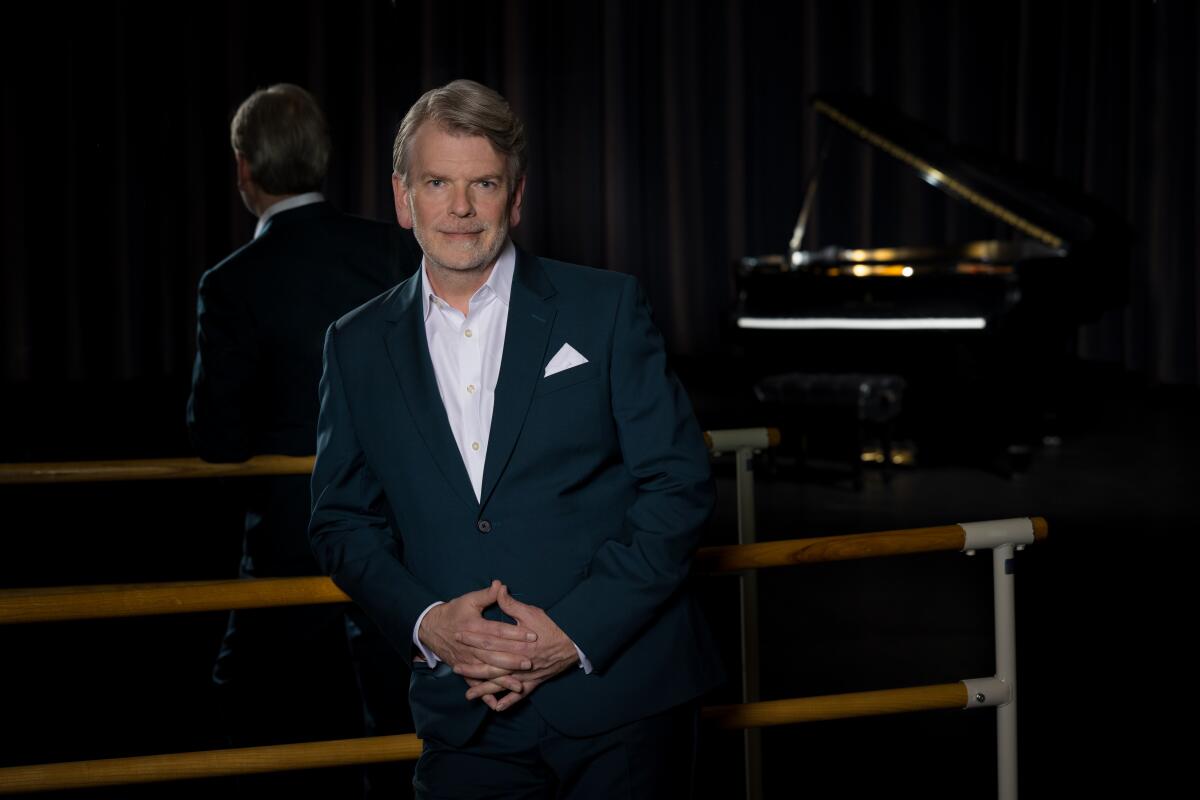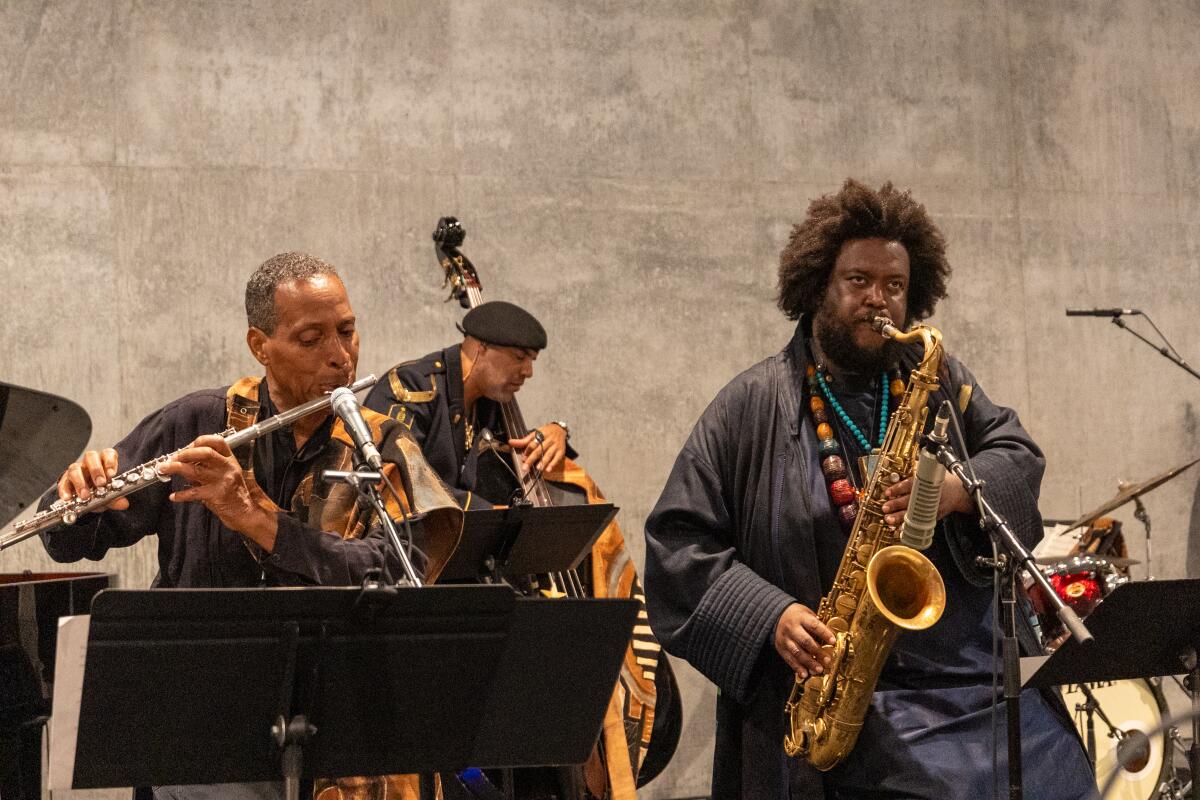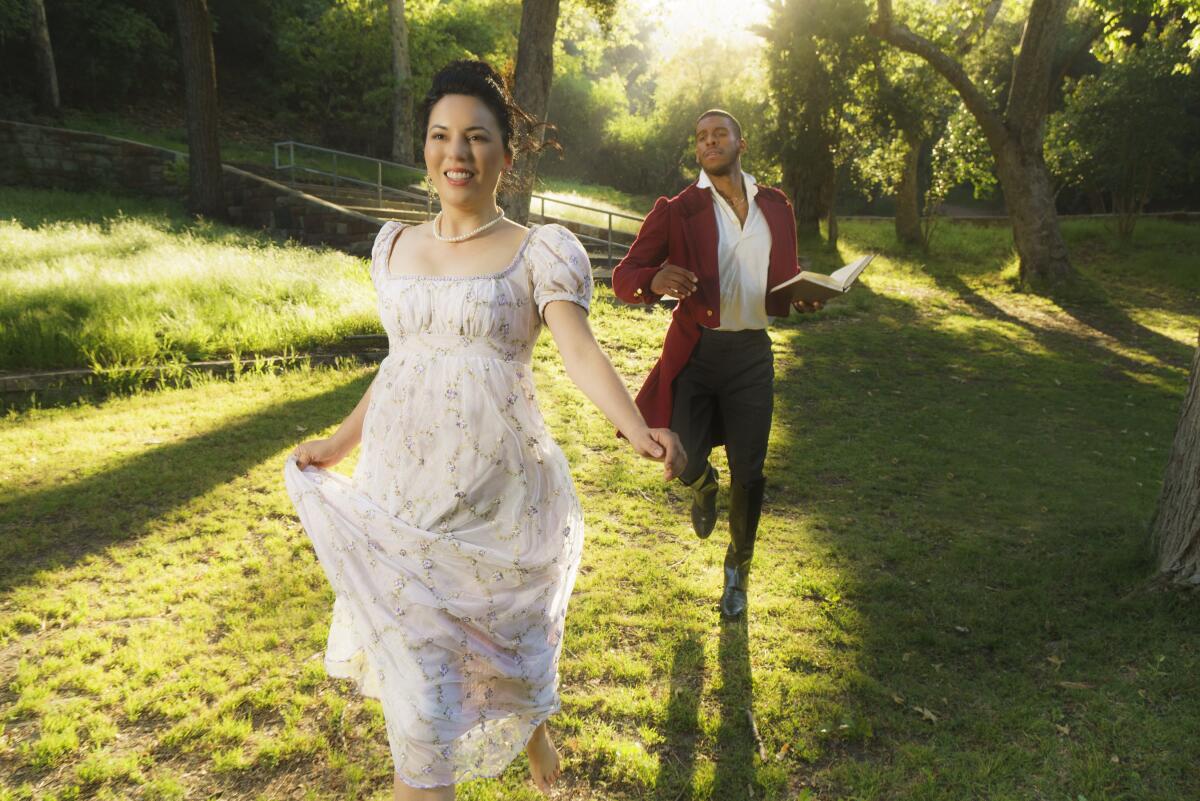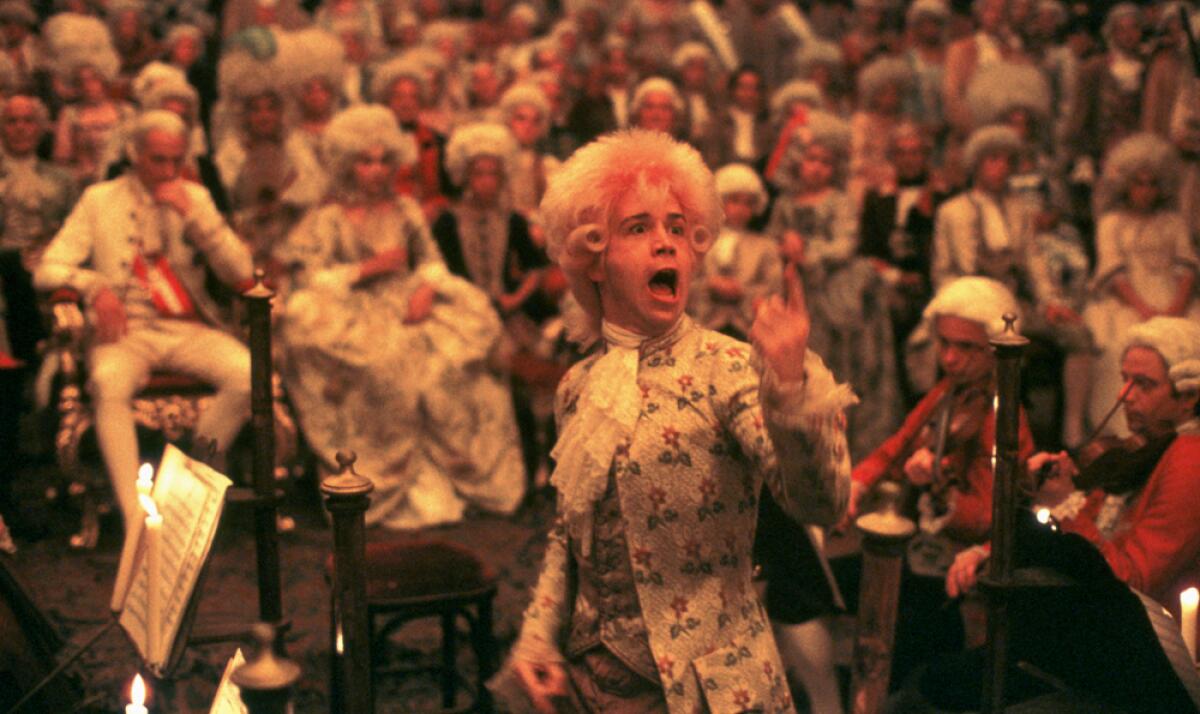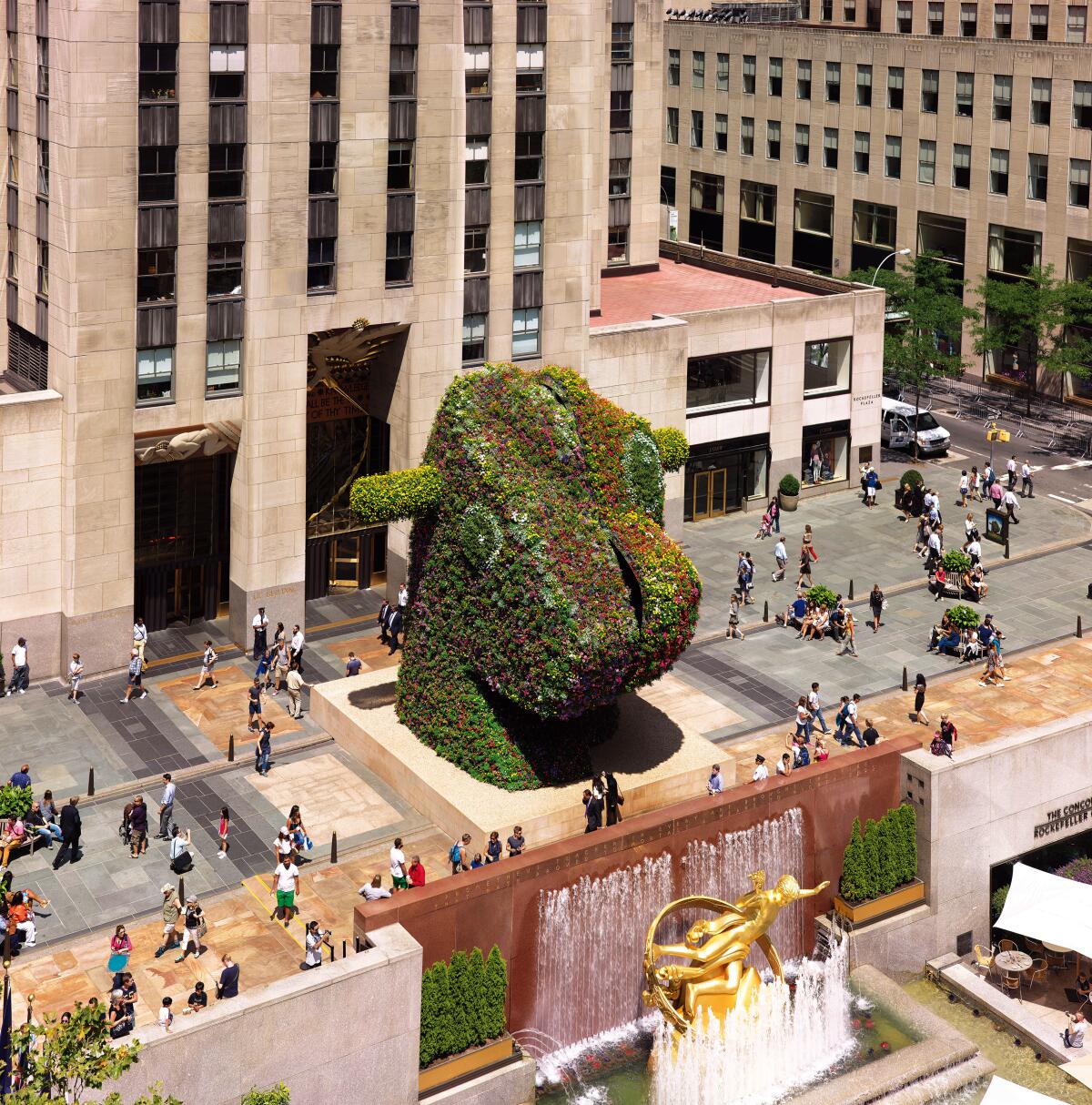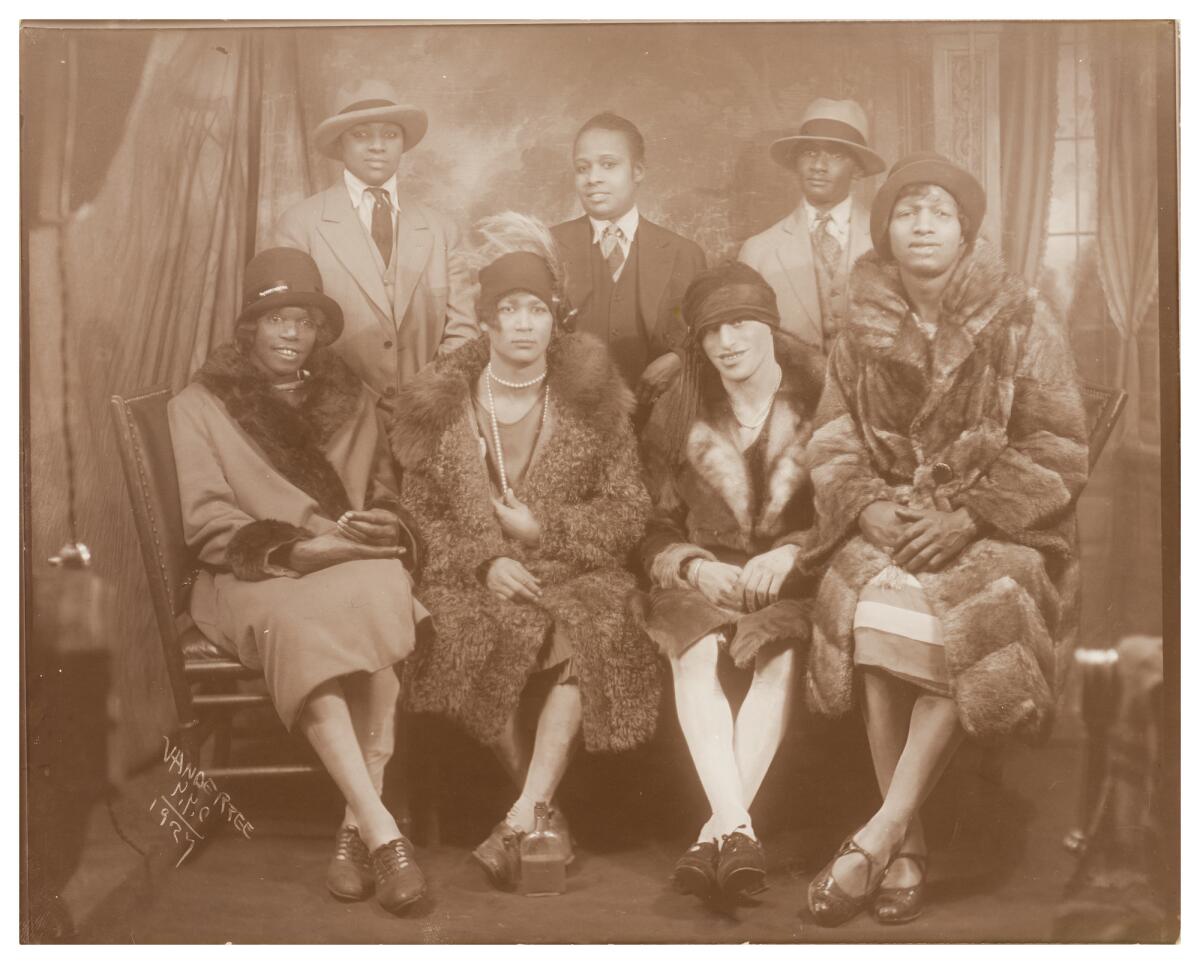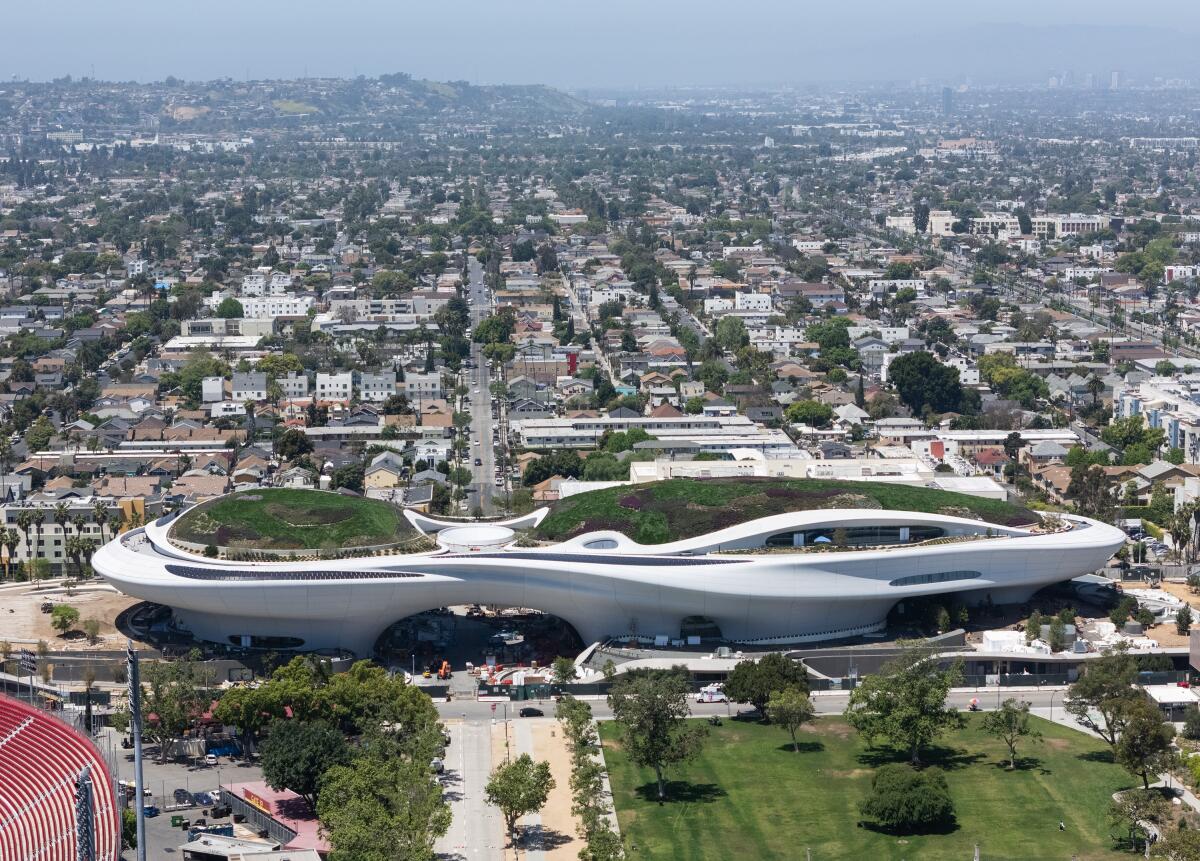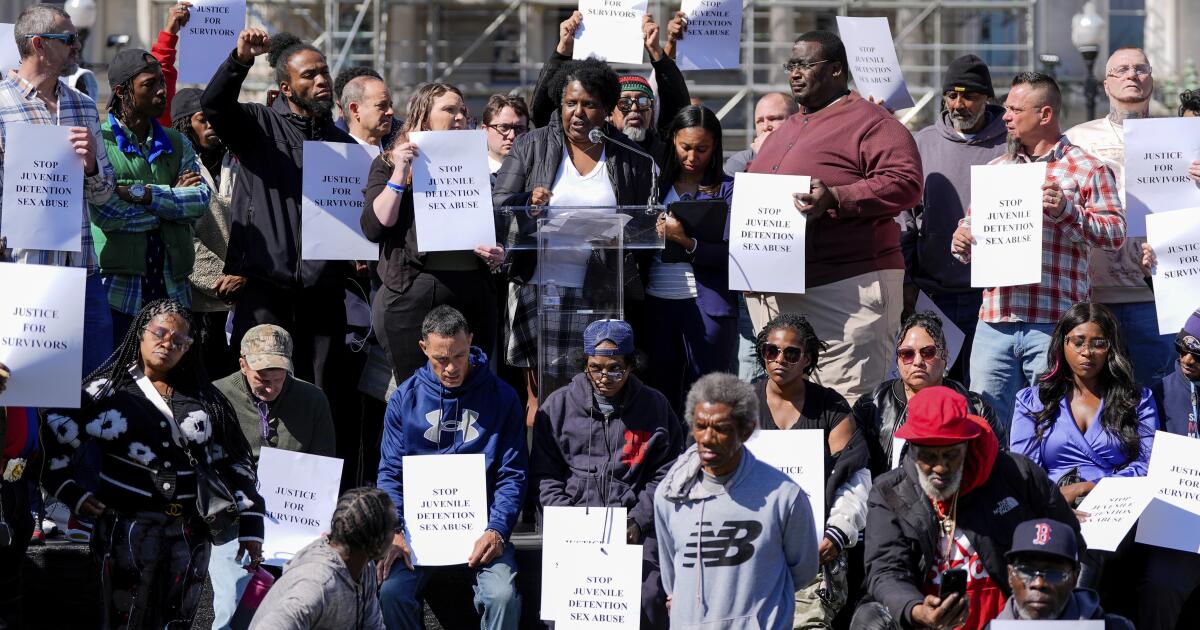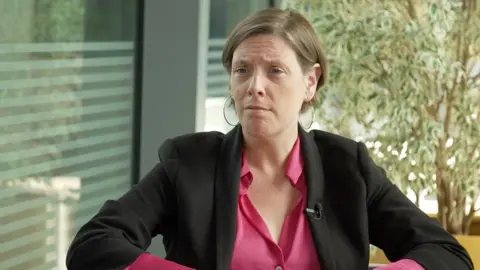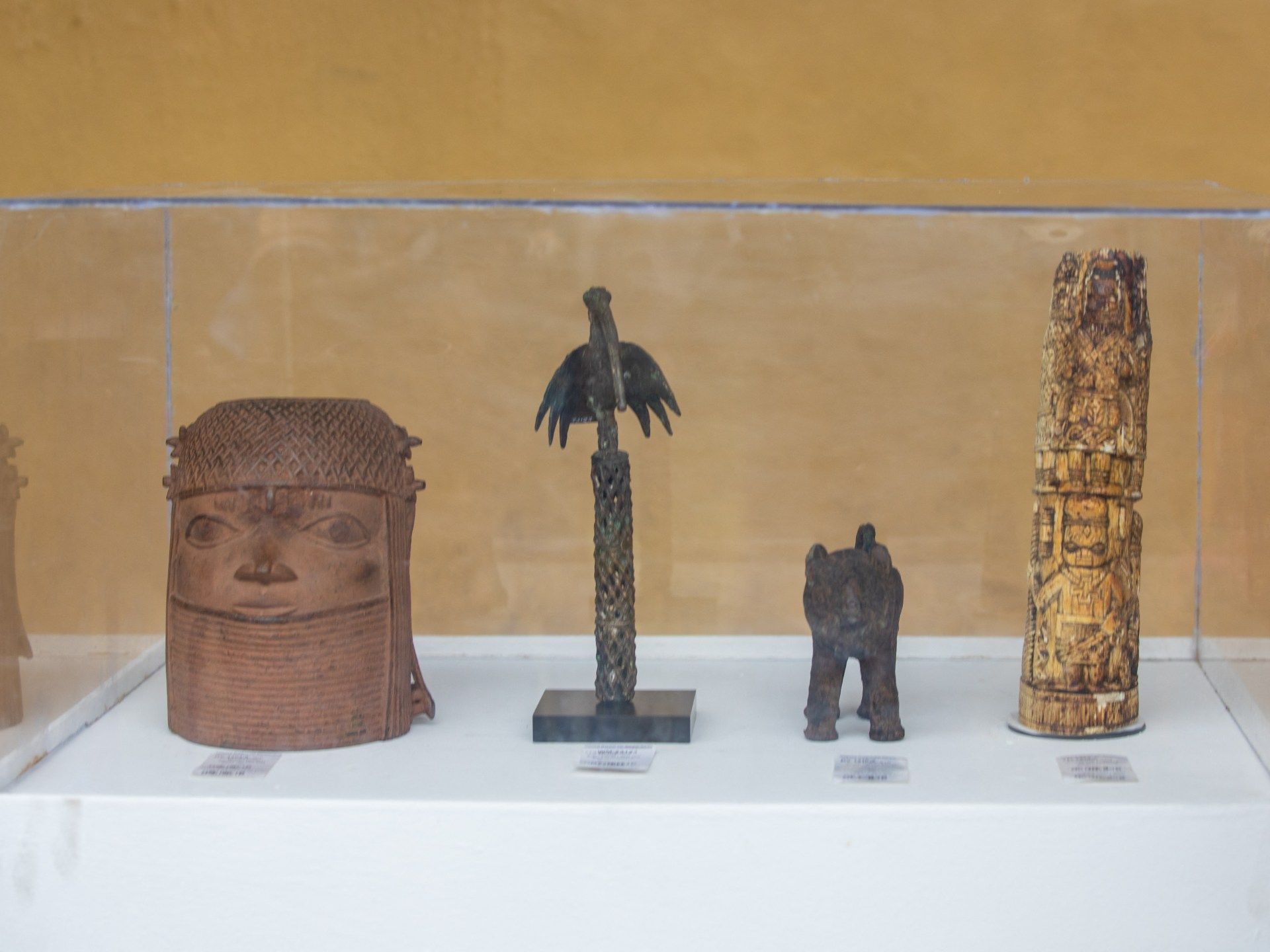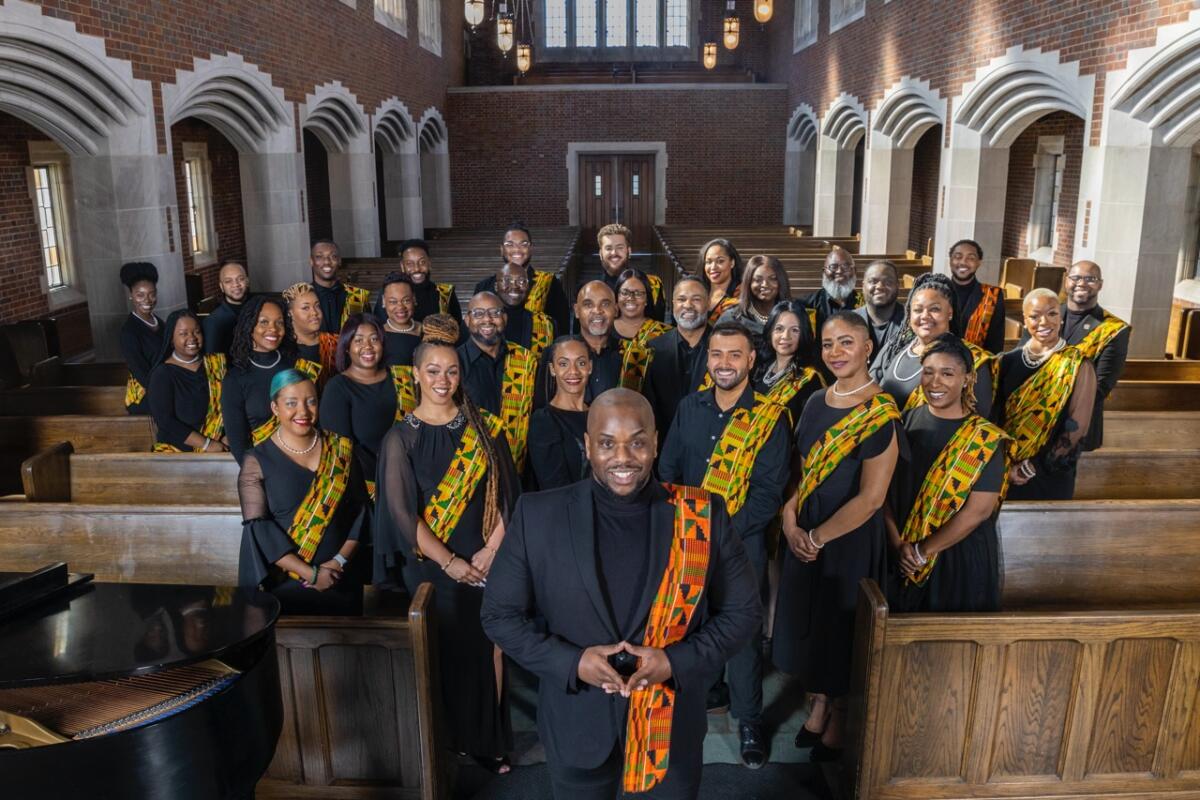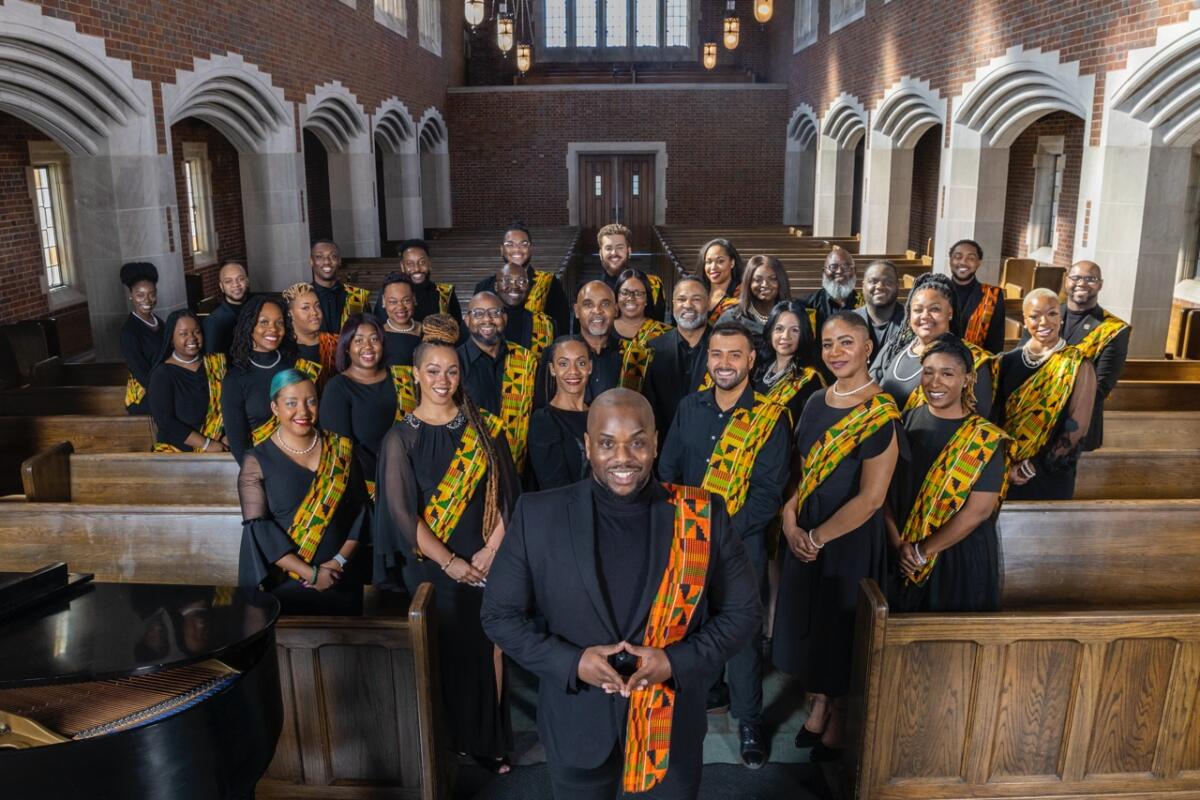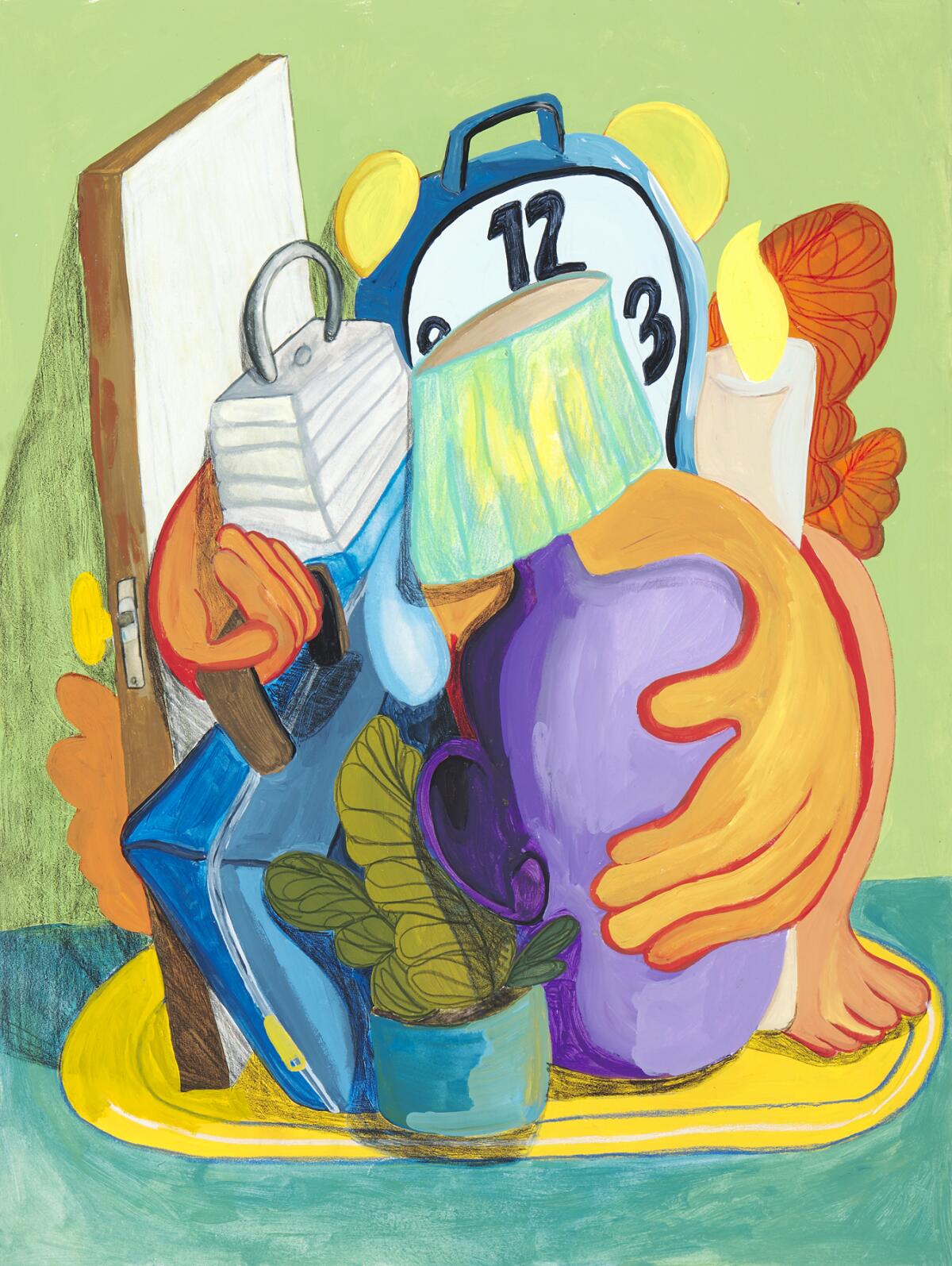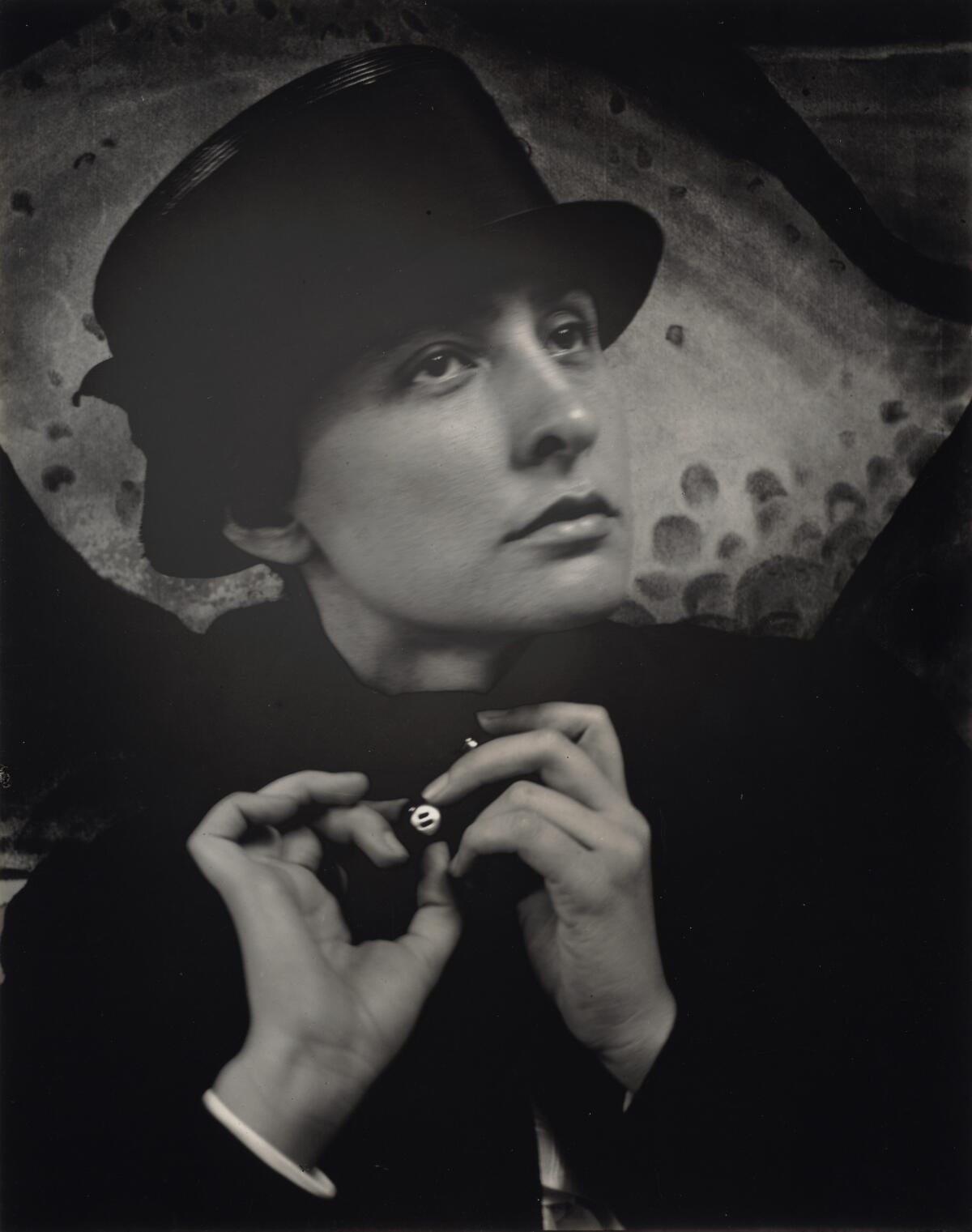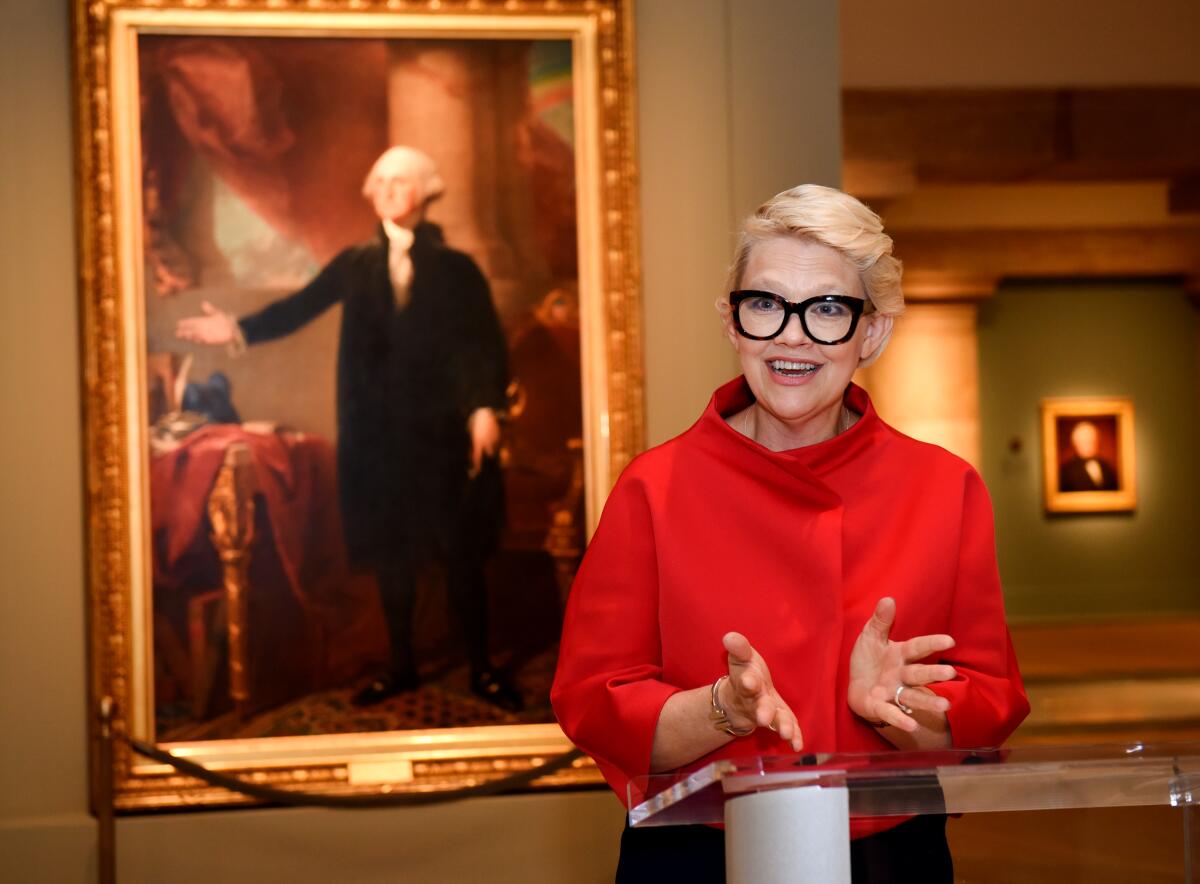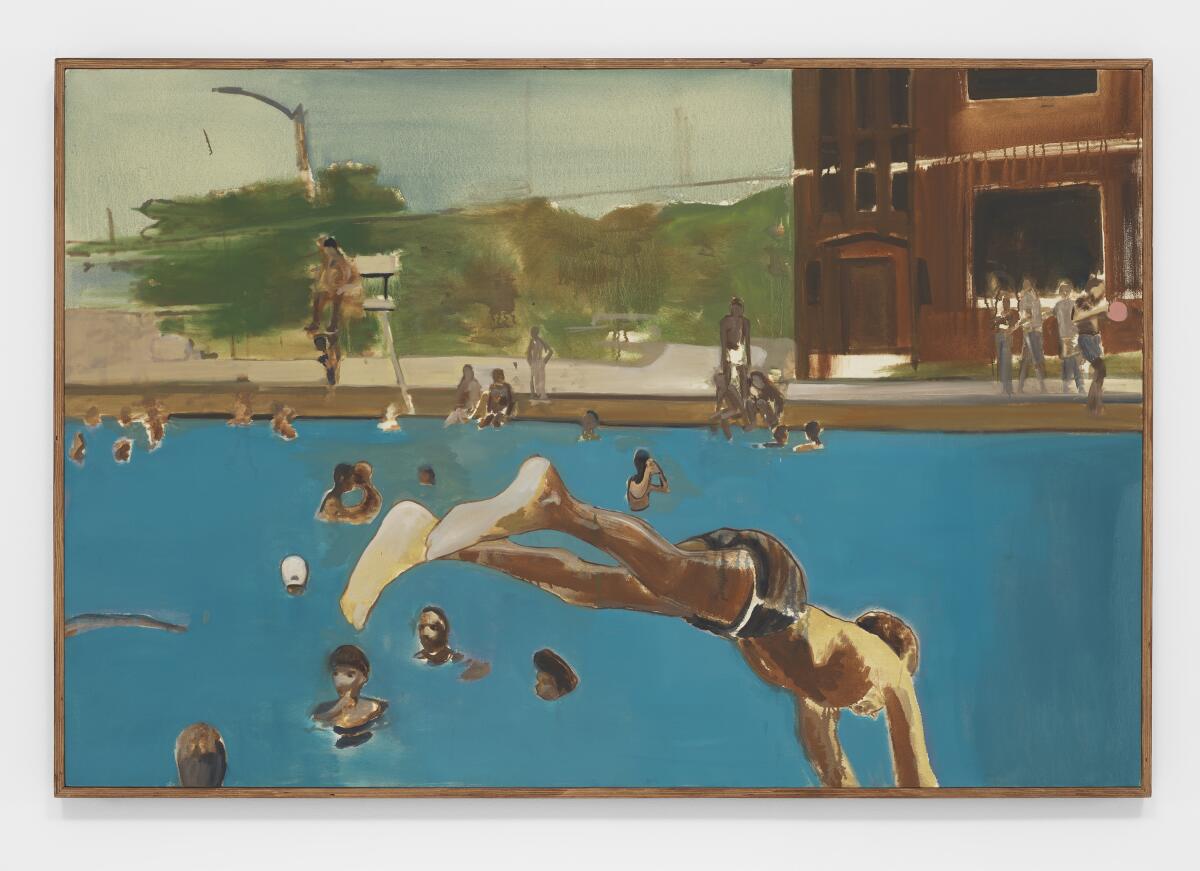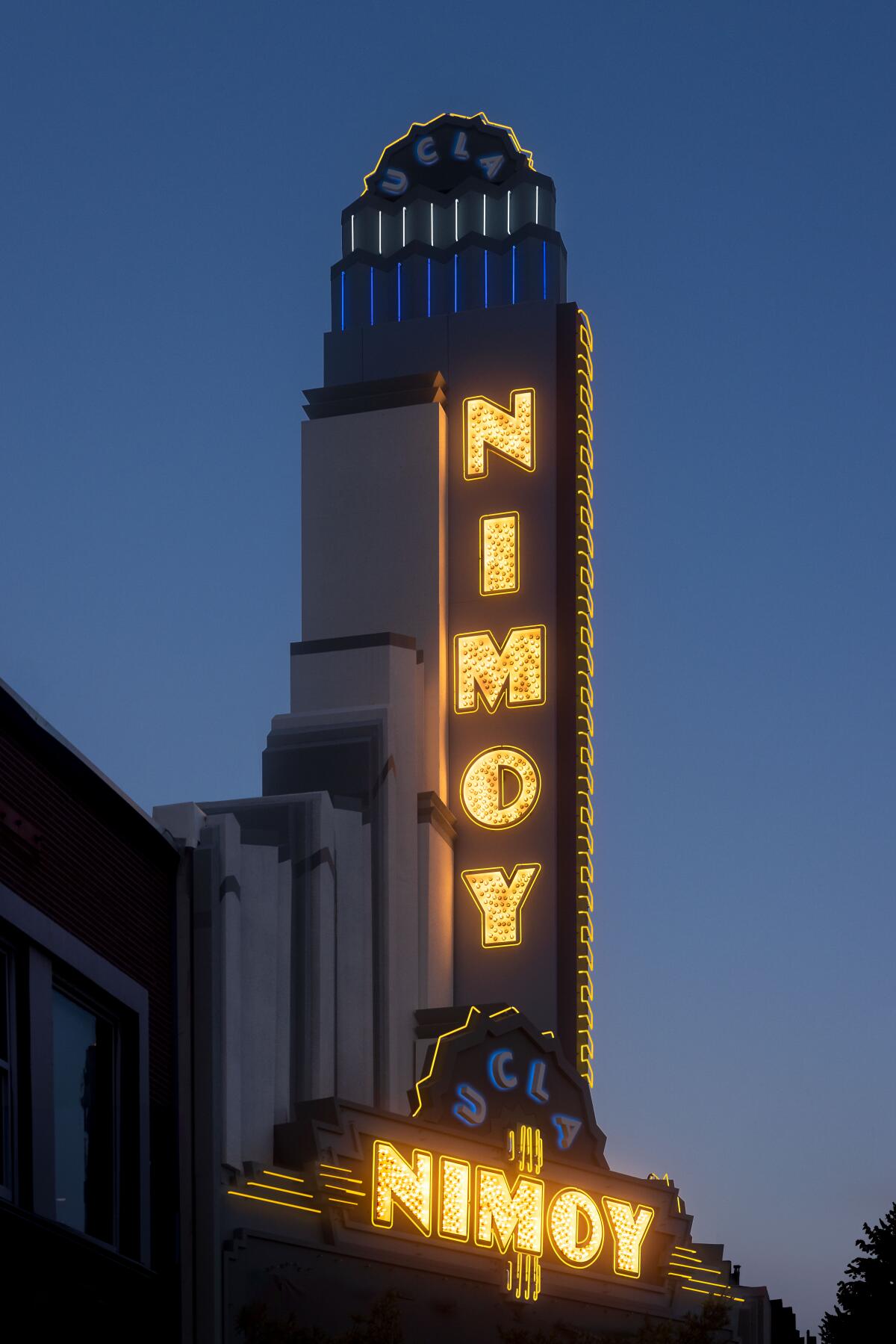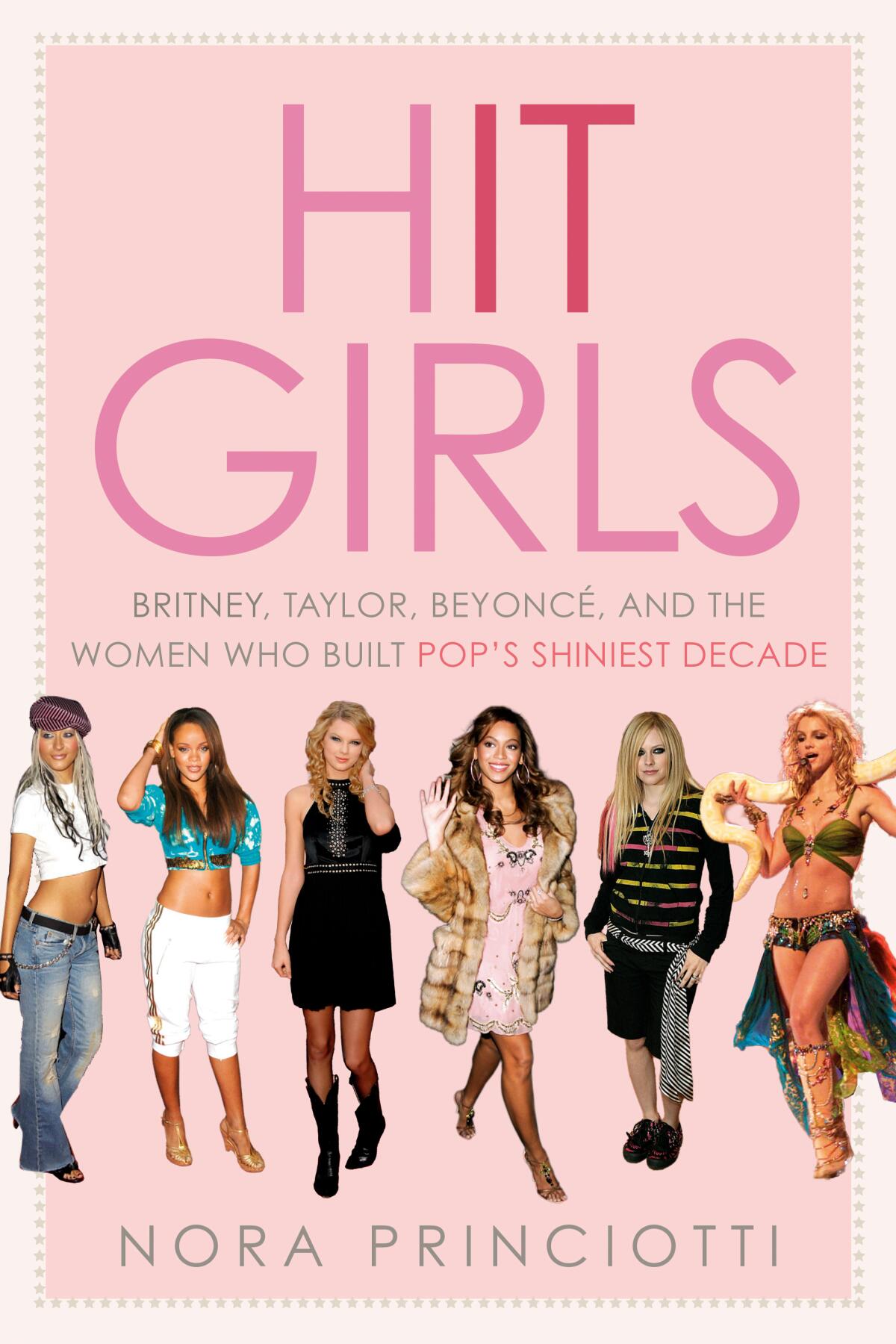Why artists loved Cole’s French Dip: L.A. arts and culture this weekend
Artists are formed by the spaces they spend time in — and in the case of countless Los Angeles artists, writers and musicians, that place was the city’s oldest restaurant and bar, Cole’s French Dip, which is slated to close on Aug. 2.
Founded in 1908 by Harry Cole in downtown’s historic Pacific Electric building, then the city’s primary railway transit hub, the legendary public house is credited with inventing the French dip sandwich after its chef dipped bread in au jus to soften it for a patron who had trouble chewing. (Note: Philippe the Original in Chinatown takes issue with this story, claiming full credit for the juicy culinary delight.)
The possibility of an apocryphal legend aside, Cole’s went on to become one of the very best bars in the area, attracting a solidly blue-collar crowd over the years, including the notoriously ribald, drunken poet Charles Bukowski. The restroom even sported a placard that read, “Charles Bukowski pissed here,” an unflinchingly literal claim to fame frequently mentioned in self-guided tours of literary L.A. (Barney’s Beanery in West Hollywood has a less off-color plaque at its bar in reference to Jim Morrison, who allegedly relieved himself on the spot without heading for the urinals.)
I like to think of Bukowski with a beer and a shot of whiskey in front of him, scribbling away on a napkin at the bar in Cole’s. I’ve done the same over the years, having discovered the bar in 1999 when I first moved to Los Angeles. Downtown was not on the up-and-up in those days, and Cole’s had fallen on hard times but was still beloved.
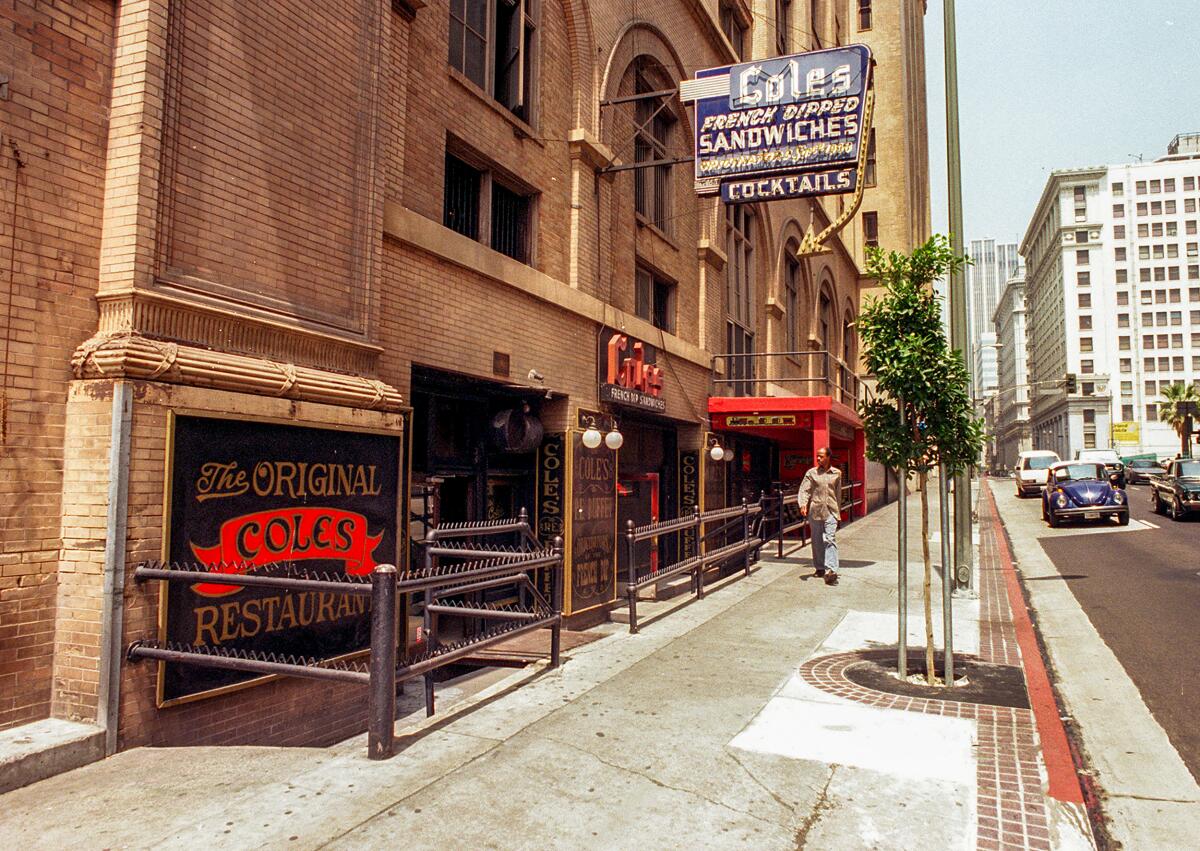
Cole’s French Dip in 1996.
(Con Keyes / Los Angeles Times)
My rock band played a few shows in its back room, and I fell in love with what was at the time a true dive bar — a place where the occasional unhoused patron spent his Social Security check alongside a smattering of unknown, paint-spattered artists who stopped by from nearby studios. I remember meeting a musician there one night who invited me and a friend to his 6th Street loft and showed me literally thousands of records stacked like a maze throughout the space, so high that you couldn’t see over them, so many that I wondered if he had space to sleep.
Cole’s was that kind of bar — a refuge for artists and misfits, a place that didn’t care what your story was as long as you had a good one.
The last time I went to Cole’s before downtown bar magnate Cedd Moses (artist Ed Moses’ son) bought it and restored it to its early 20th century glory, a rat ran over my foot as I sat at a torn, tufted banquette. I love a good dive (my husband proposed to me at the now-shuttered Brown Jug in San Francisco’s Tenderloin District), but that was a bridge too far, even for me.
Moses has long had a deep affinity for dive bars and, in the aughts, went about transforming and resurrecting a number of spaces in downtown L.A., including Cole’s, in ways that stayed true to their historic integrity. His 213 Nightlife Group (now called Pouring With Heart), was integral to downtown’s prepandemic boom.
That downtown is once again suffering from the kind of trouble and malaise that beset it in the ’80s and ’90s should be cause for great concern. On the bright side, it’s times like these when artists can again afford to move in. Maybe they can rally to save Cole’s.
I’m arts and culture writer Jessica Gelt, warning you that there is now often a line to get into Cole’s, but encouraging you to go anyway. Paying your respects to the classic institution is worth the wait. Bring a good book and a sketch pad.
Best bets: On our radar this week
Newsletter
You’re reading Essential Arts
Our critics and reporters guide you through events and happenings of L.A.
You may occasionally receive promotional content from the Los Angeles Times.

Uma Thurman in “Kill Bill: The Whole Bloody Affair.”
(Andrew Cooper / Miramax Films)
‘Kill Bill: The Whole Bloody Affair’
Quentin Tarantino presents rare screenings of the complete version of his four-hour martial arts epic that brought together “Vol. 1” and “Vol. 2,” with additional flourishes. Uma Thurman stars as the Bride in a quest for revenge against the title character (David Carradine) and his band of assassins (Lucy Liu, Daryl Hannah, Vivica A. Fox and Michael Madsen). Added flair: It’s the filmmaker’s personal 35 mm print screened at the Cannes Film Festival in 2006, so it has French subtitles.
Friday-Tuesday, Thursday-July 28. Vista Theater, 4473 Sunset Drive. vistatheaterhollywood.com
Artemisia Gentileschi in Naples
Curator Davide Gasparotto discussses the Italian artist’s work from the period she spent in Naples beginning in 1630. Gentileschi quickly became one of the most in-demand painters in the region, and Gasparotto illustrates the large-scale works, including the newly restored “Hercules and Omphale,” she completed during this time.
2 p.m. Saturday. J. Paul Getty Museum, 1200 Getty Center Drive, L.A. getty.edu

George Strait performing in 2021.
(Jack Plunkett / Invision / AP)
George Strait
Chris Stapleton and Little Big Town join the country legend on this stadium tour in support of his latest album, “Cowboys and Dreamers.”
5:45 p.m. Saturday. SoFi Stadium, 1001 S. Stadium Drive, Inglewood. sofistadium.com
TaikoProject
The L.A.-based taiko drumming group marks its 25th anniversary with a one-night-only concert featuring its innovative percussion work, plus guests including the Grammy-winning Latinx group Quetzal and multi-instrument soloist Sumie Kaneko, performing vocals, on the koto and the shamisen.
7 p.m. Saturday. Walt Disney Concert Hall, 111 S. Grand Ave., downtown L.A. musiccenter.org
‘Bye Bye Tiberias’
Filmmaker Lina Soualem portrays four generations of Arab women, including her mother, actor Hiam Abbass, who carry the burden of history within them and deal with an evolving meaning of home. Preceded by a 1988 short, “Measures of Distance,” in which filmmaker Mona Hatoum combines letters from her mother in war-torn Beirut with layered images and voice to question stereotypes of Arab womanhood. Both films are part of the UCLA Film and Television Archive’s series “(Dis)placement: Fluctuations of Home.”
7:30 p.m. Saturday. Billy Wilder Theater, UCLA Hammer Museum, 10899 Wilshire Blvd., Westwood. hammer.ucla.edu
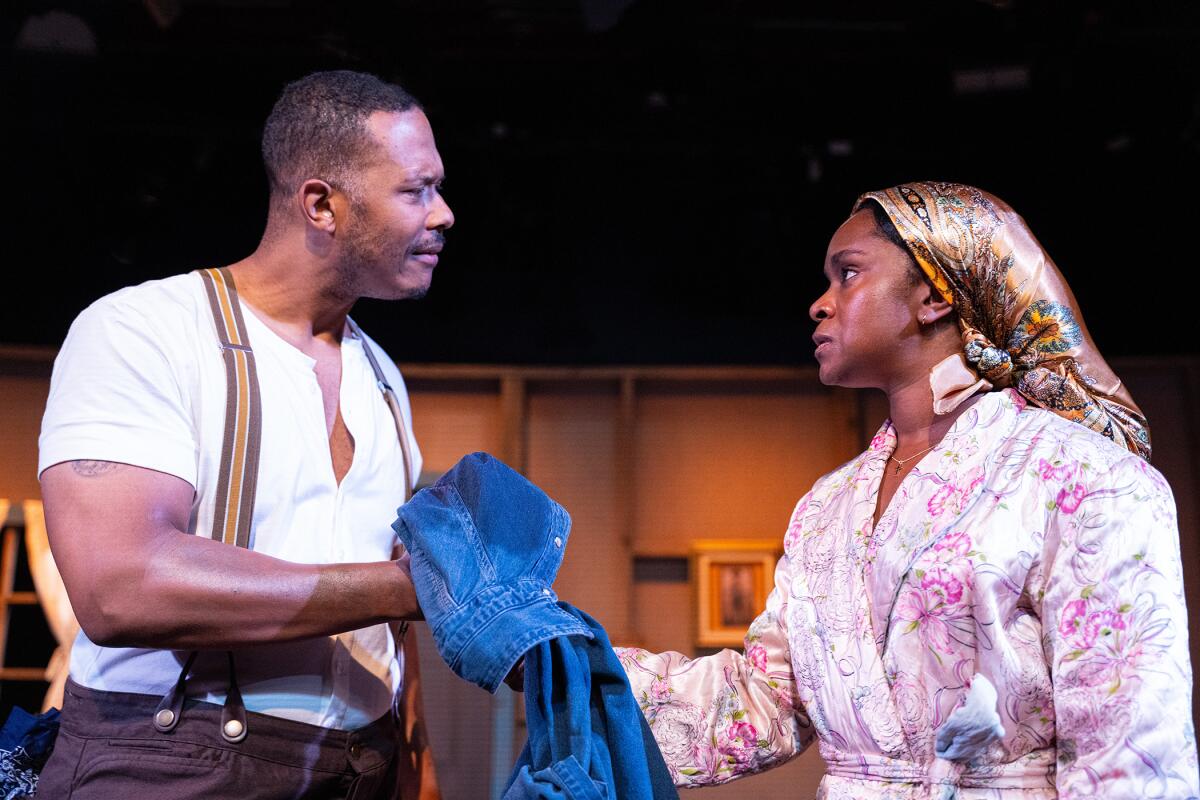
DeJuan Chirstopher and Kacie Rogers in the play “Berta, Berta.”
(Makela Yepez Photography)
‘Berta, Berta’
Andi Chapman directs the West Coast premiere of Angelica Chéri’s love story about a Black man seeking redemption in 1920s Mississippi. DeJuan Christopher and Kacie Rogers (“Furlough’s Paradise” at the Geffen) star.
July 19-Aug. 25; 8 p.m. Fridays, Saturdays and Mondays; 4 p.m. Sundays. The Echo Theater Company. Atwater Village Theatre, 3269 Casitas Ave. echotheatercompany.com
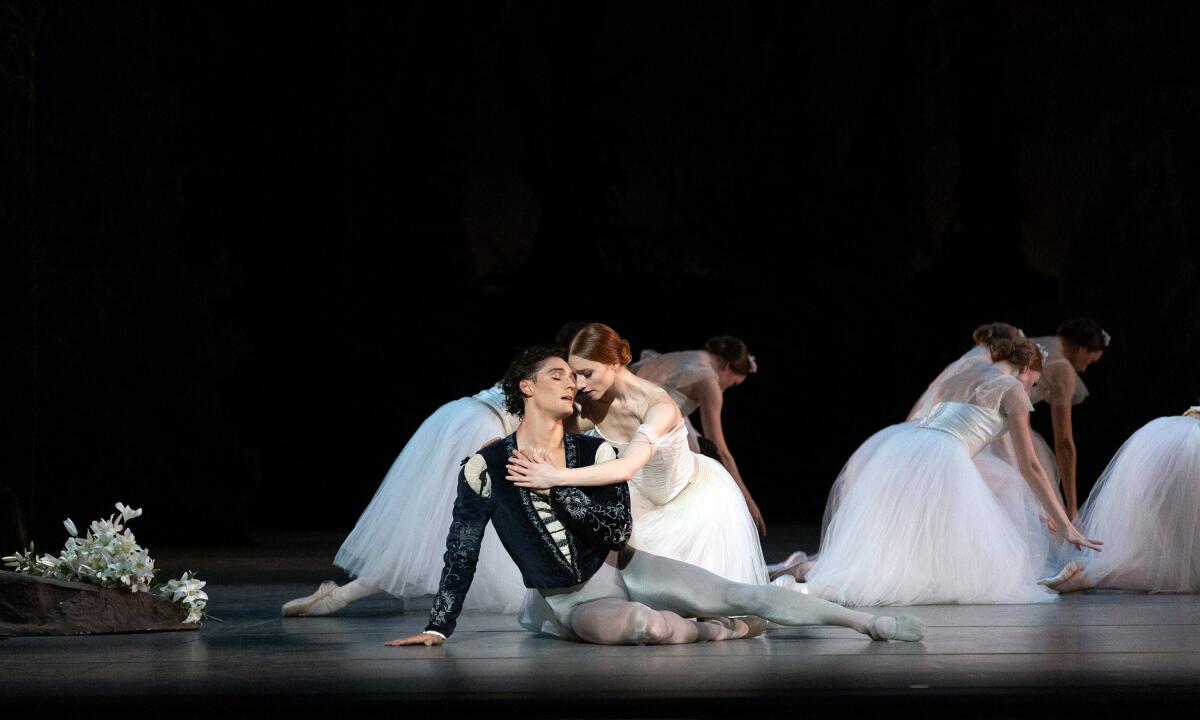
Catherine Hurlin as Giselle and Daniel Camargo as Albrecht in an American Ballet Theatre production of “Giselle.”
(Rosalie O’Connor)
Giselle
American Ballet Theatre dances this romantic tale set in the Rhineland forests where betrayal, revenge and forgiveness play out. With the Pacific Symphony.
7:30 p.m. Thursday and July 25; 2 and 7:30 p.m. July 26; 1 p.m. July 27. Segerstrom Center for the Arts, 600 Town Center Drive, Costa Mesa. scfta.org
The SoCal scene
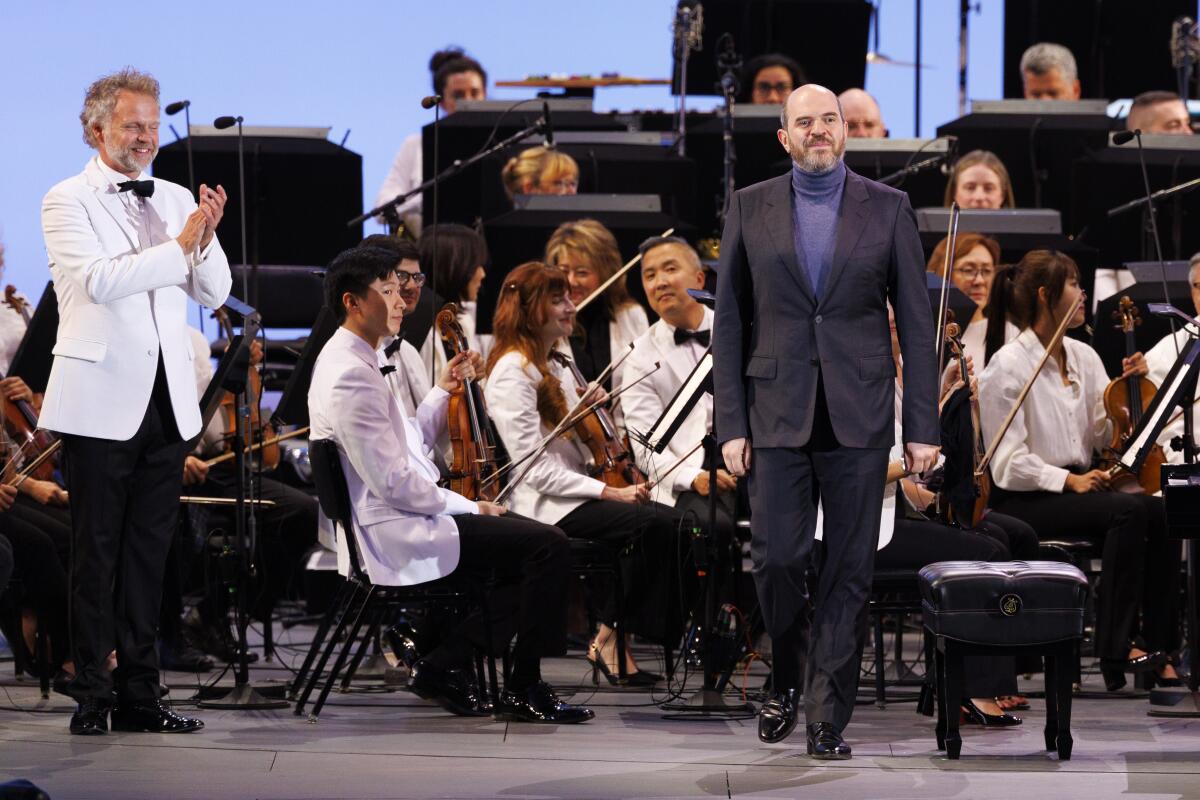
Conductor Thomas Sondergard, left, applauds solo pianist Kirill Gerstein on opening night of the L.A Phil at the Hollywood Bowl on July 8, 2025.
(Gina Ferazzi / Los Angeles Times)
The Los Angeles Philharmonic opened its 103rd season at the Hollywood Bowl earlier this month, and all was not well, writes Times classical music critic Mark Swed, noting low attendance, the cancellation of highly anticipated shows featuring Gustavo Dudamel with the Simón Bolívar Symphony Orchestra and a general edginess that has taken root in the city since the intensive ICE raids began.
“‘A Beautiful Noise’ is a jukebox musical that understands the assignment,” begins Times theater critic Charles McNulty’s review of the show playing at the Hollywood Pantages Theatre through July 27. Anyone familiar with McNulty’s taste knows this is high praise coming from a critic who often doesn’t take a shine to the genre. This musical gets a pass because it exists simply to pay tribute to Neil Diamond’s beloved catalog with “glorious” singing of “American pop gold.” Former American Idol winner Nick Fradiani delivers a “thrilling vocal performance,” McNulty notes.
The New Hollywood String Quartet celebrated its 25th anniversary with a four-day festival at the Huntington’s Rothenberg Hall, and Swed was there to capture the scene. The festivities conjured the magic of the legendary studio musicians who first formed the quartet in the late 1930s. Classical music fans and lovers of cinematic scores didn’t always see eye to eye, but it was Hollywood that “produced the first notable American string quartet,” Swed writes.
McNulty also reviewed two shows in Theatricum Botanicum’s outdoor season: “The Seagull: Malibu” and “Strife,” both of which are reimagined in the American past. Ellen Geer directed the former, setting Chekhov’s play in the beach city of Malibu during the 1970s. Geer co-directs John Galsworthy’s 1909 social drama alongside Willow Geer — moving the action from the border of England and Wales to Pennsylvania in the 1890s. The plays are ambitious, if uneven, writes McNulty.
Enjoying this newsletter? Consider subscribing to the Los Angeles Times
Your support helps us deliver the news that matters most. Become a subscriber.
Culture news
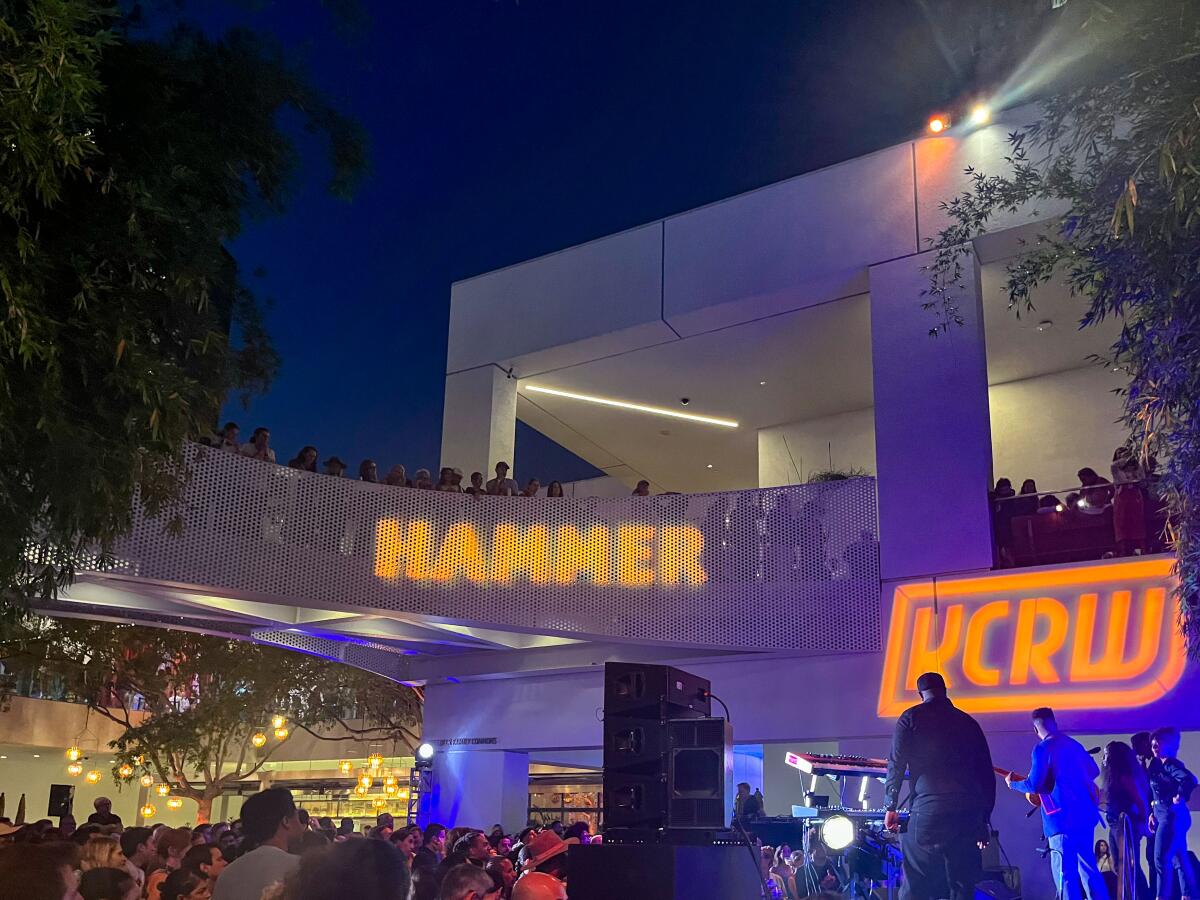
Attendees surround the stage area where singer-musician Abraham Alexander is performing with his band at KCRW’s summer nights event at the Hammer Museum.
(Kailyn Brown / Los Angeles Times)
The Hammer Museum is back with its annual summer concert series, which is free as always. There are two upcoming shows: Very Be Careful with Healing Gems and DJ Eléanora, July 31; and Open Mike Eagle with Jordan Patterson and J.Rocc, Aug. 19.
Ann Philbin, former director and current director emeritus of the Hammer Museum at UCLA, was named this year’s Getty Prize recipient. She chose to donate its accompanying, pay-it-forward $500,000 grant to NPR and its Los Angeles member stations, KCRW and LAist.
The “Jesus Christ Superstar” casting news keeping coming. Earlier this week, it was announced that Josh Gad will play King Herod and Phillipa Soo will play Mary Magdalene in Andrew Lloyd Webber’s iconic musical, staged at the Hollywood Bowl in early August and starring Cynthia Erivo as Jesus and Adam Lambert as Judas.
The Carpenter Center announced its 2025–2026 season, including an evening with Sandra Bernhard and Mandy Patinkin in concert; a cabaret series that opens with Melissa Errico performing Barbra Streisand’s songbook; a dance series featuring Alonzo King LINES Ballet; a “Wow!” series that includes the Peking Acrobats; and a Sunday afternoon concert series with a special tribute to the songs of John Lennon and Harry Nilsson.
— Jessica Gelt
And last but not least
Hot cheese bread and meat pies? Count me in!
